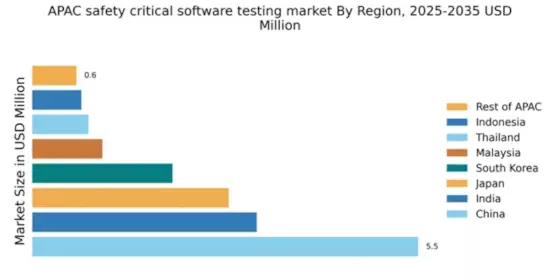China : Robust Growth Driven by Innovation
China holds a commanding 5.5% market share in the safety critical-software-testing sector, valued at approximately $1.5 billion. Key growth drivers include rapid technological advancements, increased investment in R&D, and a strong push for regulatory compliance in safety standards. The government has implemented initiatives to enhance software quality and safety, fostering a conducive environment for market expansion. Infrastructure development, particularly in transportation and aerospace, further fuels demand for safety-critical software solutions.
India : Growing Demand in Diverse Sectors
India's market share stands at 3.2%, reflecting a burgeoning demand for safety critical-software-testing valued at around $850 million. The growth is driven by the increasing adoption of digital technologies across sectors like automotive, aerospace, and healthcare. Government initiatives, such as the Digital India program, promote innovation and regulatory compliance, enhancing the market landscape. The rise in local manufacturing and infrastructure projects also contributes to the demand for robust software testing solutions.
Japan : Focus on Quality and Compliance
Japan accounts for a 2.8% market share, with a value nearing $700 million in safety critical-software-testing. The market is propelled by stringent regulatory frameworks and a cultural emphasis on quality assurance. Key growth drivers include advancements in automation and AI technologies, which enhance testing efficiency. The government supports initiatives aimed at improving software safety standards, particularly in the automotive and aerospace sectors, ensuring compliance with international regulations.
South Korea : Strong Industrial Base and Regulations
South Korea's market share is 2.0%, valued at approximately $500 million. The growth is fueled by a robust industrial base, particularly in electronics and automotive sectors, where safety-critical software is essential. Government regulations mandate rigorous testing protocols, driving demand for advanced software testing solutions. The competitive landscape features major players like L3Harris Technologies and Honeywell, which are actively involved in local partnerships to enhance service offerings and compliance.
Malaysia : Strategic Location and Development
Malaysia holds a 1.0% market share, valued at around $250 million in the safety critical-software-testing market. The growth is driven by the government's focus on becoming a regional technology hub, supported by initiatives like the Malaysia Digital Economy Corporation. Demand is rising in sectors such as manufacturing and healthcare, where software safety is paramount. The competitive landscape includes local firms and international players, fostering a dynamic business environment.
Thailand : Investment in Infrastructure and Safety
Thailand's market share is 0.8%, with a value of approximately $200 million. The growth is supported by government investments in infrastructure and a focus on enhancing safety standards across industries. Key sectors include automotive and aviation, where safety-critical software is increasingly vital. The competitive landscape features both local and international players, with a growing emphasis on compliance with international safety standards, driving demand for advanced testing solutions.
Indonesia : Emerging Opportunities in Testing
Indonesia's market share stands at 0.7%, valued at around $180 million. The growth is driven by increasing digitalization and a rising focus on safety in sectors like transportation and healthcare. Government initiatives aimed at improving software quality and safety standards are pivotal in shaping the market. The competitive landscape is evolving, with local firms beginning to collaborate with international players to enhance their service offerings and compliance capabilities.
Rest of APAC : Varied Market Dynamics Across Regions
The Rest of APAC holds a market share of 0.63%, valued at approximately $150 million. This sub-region encompasses a diverse range of markets, each with unique growth drivers. Demand for safety critical-software-testing is influenced by local regulations and industry needs, particularly in sectors like manufacturing and healthcare. The competitive landscape varies significantly, with both local and international players vying for market share, adapting to regional dynamics and regulatory requirements.


















Leave a Comment